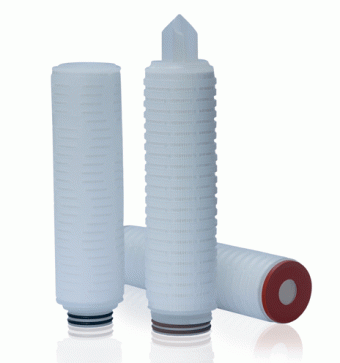
FIBER PRO
X
TAKING FIBERS TO THE NEXT LEVEL
FILTRATION
ABOUT FILTRATION
PRO TIP: WORK WITH OUR EXPERTS TO GET CUSTOM GRADE FIBERS.
WHAT ARE FILTER AIDS?
Filter aids are used to separate solids and particulates from large volume of liquid. They reduce the cost of filtration by avoiding the use of large multi-round cartridge filters. Filter aids are used in pharmaceutical, food procession, wastewater recovery and waste treatment.
Filter aids are made from different types of inorganic mineral powders or organic fibrous materials that is used on a combination of filtration hardware to enhance filtration performance. The most common types of filter aid use in the wine industry are cellulose, diatomaceous earth, perlite and various combinations of other of them. The goal is to reduce turbidity with the greatest flow rate. To do so different grades are produced in a wide range of permeability to produce the desired clarity.
FILTRATION MEDIA TYPES
Cellulose, Diatomaceous Earth, Perlite, and combination filter aids are the most widely used filter aids. Filter aid is used on all filtration equipment to achieve the desired clarity.

Cellulose. For the wine and juice industry, the cellulose fibers are milled to specific length and width for the highest demands of winemaker. It is the most renewable raw material in nature. It is a natural organic material. If is completely biodegradable and so environmentally friendly. There is a lower specific consumption on average 70% less when compared to DE. It has higher flow rates and longer filter runs.
It contains no silicate, crystalline components, non-toxic. Cellulose requires no personal protection equipment. The disposal is down the municipal waste system, compost back into the field or used for cattle feed. The cake is very stable and resistant to surge. Since cellulose contains no silica, it in non-abrasive making it easy on pump, pipes and equipment.
Cellulose is an excellent precoat material because of it can easily coat the screens. If there is a hole in the cloth or screen, the cellulose fiber will overlap each other in a bridging effect seal the hole. This prevents blow by of filter aid into the wine or juice. The same overlapping of the cellulose fiber is how particles are retained. Small short fibers create a tight pattern of overlap for greater particle retention. Large longer fibers create a coarser filtration.
All of our α-cellulose has a natural charge without the addition of resin. This is because of the hydroxyl groups on the cellulose strains. Van der Waals force binds carbon to the α-cellulose reducing bypass. This allows for greater carbon removal. We at CreaFill are the leader in the milling of cellulose fibers. Based on the equipment you use and the desired clarification we can mill fibers to fit you need. We can mill fibers that are straight cut, fibrillated or cubed in shape. Because of this, the same fiber that is equal in length and width will filter completely differently because of changing the shape.
For the wine and juice industry, CreaFill mills three CreaClear grade. For rough filtration, CreaClear SC200 is used for upstream filtration, SC 150 for medium or RotoVac and SC90 for fine filtration. CreaFill recommends CreaClear for all wine and juice filtration.
In summary, all of our fibers are α-cellulose with a natural charge. We add no resin to obtain this charge. Cellulose also has the ability to operate in elevated pH environments above 10, making it frequently used in the chlorine-caustic industry to filter the brine feed to electrolysis membrane separators. There is no chemical reaction with brine and minerals because cellulose is inert.

Diatomaceous Earth (DE) contains diatomite, which are fossils of single cell algae with silica. The diatomite fossils keep it shape through separation and thermal processing. When processed with heat the fossil shape elongates and becomes sharp. When inhaled the crystalline particulates get lodged in your lung giving silicosis and/or lung cancer. DE fossils are highly porous structure composed primarily of silica, along with impurities of alumina, iron oxide, and alkaline earth oxides. Solids being trapped in the pores and silica achieve particle retention.
The advantage of DE is the ability to filter to high clarity and its price. There are several disadvantages to using DE are numerous. They include impurities, heavy metals such as lead and arsenic and the cost of disposal is a real problem. The high silica content causes it to be listed as a Class 1 carcinogen and requires special OSHA approved respirators.

Perlite is a naturally occurring volcanic glass that thermally expands upon processing. Perlite is chemically made of sodium, potassium, and aluminum and silicate. After milling, a porous, complicated structure is present, but because its structure is not as intricate (or tortuous) as that of cellulose or DE, perlite is better suited to the separation of coarse microparticulates from liquids having high solids loading rather than fine filtration.
Combination Filter Aid. Several products use a combination of cellulose, cotton and perlite to make various types of filtration aid. Most are made without the addition of resin for precoating and rough filtration.
FILTER AIDS
Grade Selection and Optimization. Filter aid products come in a family of grades over a wide permeability range. Permeability is a constant used to describe the intrinsic fluid flow of a liquid through a powder media. A thorough discussion of filtration mechanics can be found in numerous reviews. Various methods of measuring of measurement are used.
For this report, I have combined cartridge filters, filter aid, d’Arcy permeability and standard flowrates to help make a comparison between the different types of filter aid. The tables provided will allow you to compare each of the different types of filter aid.
The selection of the appropriate grade of filter aid has been done initially lab-scale or pilot-scale trials. There is no substitute for this testing, however the tables provided will give a good starting point on where to begin the trials. This comparison table should reduce the number of tests that needs to be screened. When selecting filter aid there is always a tradeoff between what is retained and flow rate. There are four criteria to consider when selecting an appropriate grade of filter aid.
1) Filtrate Clarity | The filtrate clarity must meet or exceed the needs of the cellar master. The better the upstream filtrate the better we can extend the life of the final filter. Both the grade of filter aid and how much particulate should be removed. Once this is established, body feed is added to maintain the filter cake.
2) Product Throughput | The amount of product throughput is determined by the grade selected. The goal is to select the correct the grade of filter aid that gives you the correct particle retention and throughput. If the grade is too fine, we get premature plugging. If too open, you get high throughput without the desired clarity.
3) Product Yield or Recovery | The more you filter aid you use the greater the product lost in the filter aid. You want to maximize your product lost by using the right filter aid that gives the best clarity and product throughput.
4) Product Stability and Purity | You want to reduce the amount of heavy metal is added to wine or juice. High concentrations of soluble metals can oxidize in wine or juice causing product instability. Solid-state metal oxides can function as sources of catalytic oxidation activity. Cellulose contains no metal or additives. By using a high purity fiber such as cellulose fibers for filtration will help reduce or eliminate product contamination and degradation issues further downstream.
CREAFILL CREACLEAR FILTRATION (LIQUID SEPARATION)
WE ARE A DISTRIBUTOR FOR CREAFILL CREACLEAR.
Separation processes demand clarity, efficiency and safety.
CreaClear can be used as a precoat for polishing liquids and preventing the bleed-through of Diatomaceous Earth. As well, CreaClear can be used as a stand alone filter aid for exceptional purity and clarity. The fibers build a matrix that capture particles while improving flow rates and extending filtration cycles. Cellulose fiber is a natural product and poses no contamination hazards, and it can be easily disposed of by incineration or composting.

CreaClear Filter Aids for Filtration Efficiency and Cost Savings
A filter cycle with high particle content reaches maximum particle loading, blinding the screen and prematurely ending the filter cycle causing downtime, and significant energy loss.

Utilizing CreaClear builds a matrix to capture particles at a staggered rate extending process time, improving volumetric flowrate and energy usage, while lessening plant downtime.
P = Pressure Drop Q = Volumetric Flow Rate t = Time
Performance
-
Fast precoat cake formation
-
Quick release of spent cake
-
Extended filtration cycles
-
Improved filter efficiency
-
Lower filter aid consumption
Efficient Particle Capture
-
Proven efficiency for particle capture
-
Adsorption of trace metals
Energy Efficiency
-
Extends filter run time by forming a matrix that allows liquid to pass while capturing particles
-
Limits pressure drop by creating an intricate lattice through which liquid can pass
Environmentally Friendly
-
Natural product derived from renewable resources
-
Organic
-
Safe for workers to handle
-
No silica hazards
-
Combustible for incineration
-
Biodegradable
-
Suitable for compost or animal feed
-
Renewable resource raw material
Iron Adsorption
CreaClear is proven effective at adsorbing trace amounts of iron. This attribute aids brewers and vintners in improving product quality and extending shelf-life. Also, CreaClear when used as a pre coat for diatomaceous earth (DE) adsorbs iron that leaches out of the DE -- All attributes proven to improve filtrate quality.
Improved Efficiency
CreaClear is proven to pick up fine particles with more coarse grades providing increased permeability and flow rates. CreaClear provides extended filtration runs, which are critical in saving energy costs and are achieved while improving filtrate quality.
Starting Recommendations
-
CreaClear’s optimal pressure usage range is up to 35 psi
-
CreaClear is a natural fiber that is insoluble and inert
-
CreaClear’s volume in liquids can increase from three to ten times its size depending on fiber grade selection and operating pressure
-
CreaClear is a compressible cake allowing maximum filtrate extraction
-
For a single layer of precoat we recommend starting with five to seven pounds per 100 square feet of filter area (2.50-3.25 kgs/10m2)
-
To use CreaClear as an admix, do not exceed 5% to 6% by weight solids concentration in the admix tank. Feed rates will be determined by the percent and type of solids to be separated
Flexibility to Meet Your Needs
-
CreaClear is available in standard bag sizes. Custom packaging, labeling and palletizing is available.
-
CreaClear products are made to specification and a certificate of analysis is provided for each lot. Consistency and purity are guaranteed.
CreaClear is available in grades to match your requirements from highly pure alpha celluloses with unique filtration characteristics to reclaimed fibers for use as absorbents – We can meet your unique requirements.
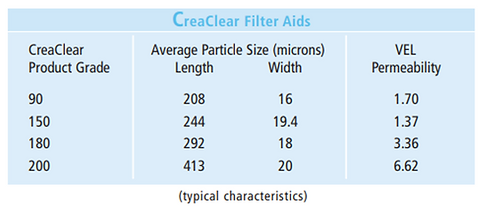
ADVANTAGES
The advantages are clear:
-
Low wet density
-
Inert and insoluble
-
Stable within a pH range from 4 to 12
-
Combusts nearly ash free
-
Renewable resource product
-
Safe for workers to handle
-
Savings on decreased filter aid consumption
-
Excellent filtrate clarity
-
Bridges rips and tears in the filter cake
-
Provides long filter cake constancy
-
Can be incinerated, composted or if suitable used as animal feed
-
Reduced disposal costs due to low filter cake moisture content
APPLICATIONS
CreaClear Filter Aids are suitable for use on all precoat filter machines.
CreaClear is used in a variety of applications:
Food
-
Wine
-
Beer
-
Fruit juice
-
Sugar
-
Edible oils
-
Alginate
-
Gelatins
-
Vinegar
-
Pectin
Industrial
-
Cooling lubricants
-
Brine (Electrolysis)
-
Condensate
-
Grinding water
-
Galvanic baths
-
Anodic oxidation treatments
-
Solvents
-
Mineral oils
Pharmaceutical
-
Antibiotics
-
Blood plasma
-
Vitamin solutions
-
Proteins
FIBER COMPARISON

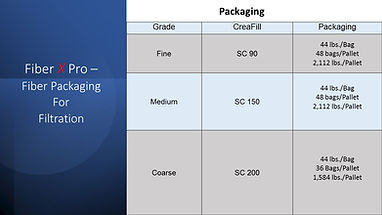

CreaClear is available in grades for food and technical filtration.
CARTRIDGE FILTERS

Fiber X Pro searched many companies to make our custom filter cartridge and filter housings. Our requirements in selecting a filter company were to be in full manufacturing compliance accordance with international standards, use materials for cartridges currently used in biopharmaceutical and food markets, assure they are listed in the FDA file and passed the USP (United States Pharmacopeia)
requirements for Class VI-121 biological safety testing of plastics.
We wanted to make that manufacturing followed strict ISO9001 quality management system, tested with various analytical apparatus and equipment for quality control purpose and can be delivered on time. We achieved all of the above.
Our filter cartridges and housing have been used successful application across all major industrial
markets:
- Pharmaceutical
- Food and Beverage
- Drinking Water
- Swimming pool and spa
- General industrial process fluids
All capsules and cartridges are manufactured in both industry standard and customer specified formats in Class 100,000 or 10,000 Clean Rooms. Filter technologies range from small disc capsules and cartridges to capsules with full size cartridges.
Questions to Ask About Your Filtration Need
-
Why are you filtering / what is your filtration application?
-
It’s imperative to have a firm grasp on the type of filtration you anticipate performing as that will dictate how you should move forward when selecting the appropriate type of filter.
-
-
What are your process conditions / requirements?
-
Being armed with the knowledge of the desired or expected flow rate, pressure drop, and throughput of your process will assist in narrowing down your choices of filters that will meet those demands. These three particular parameters are always dependent on your system and will be affected by any changes within your system, and over time if their values begin to fall short of expectations this change serves as an important first step for troubleshooting your system to determine potential failures.
-
-
What are the characteristics of your contact fluid(s)?
-
Having a clear understanding of the type of fluid being used in your filtration application will save you a ton of time and reduce frustrations so it’s always advisable to consider if your filtration fluid will be gaseous or aqueous, its properties, and its composition.
-
-
What filter characteristics are most important for your process?
-
There are many filter characteristics to consider prior to selecting the most appropriate filter for your process. Let’s look at two of these characteristics – filter capacity and recovery efficiency. A filter’s capacity will correlate to how much particulate a filter can capture before plugging occurs. While thinking about your filtration process you may need a filter with a higher capacity to serve as a pre-filter to capture larger sized particles first so that your main filtration media does not clog unexpectedly. Also, a filter may remove particles that are essential to your process and the likelihood of this occurring is gauged by the filter’s recovery efficiency. The recovery efficiency provides insight on the amount of material recovered relative to the amount of material originally in place.
-
-
Will the filter need to be sterilized or sanitized? If so, how often?
-
With respect to sterilization, there may be a need to pre-sterilize filters because they will be used in a clean room where the particulate level is required to be as close to zero as possible. Additionally, it’s important to consider the need for sterilization early in the decision stage because each filter has different options of sterilization (gamma, ETO, autoclave), and each filter must be compatible with the sterilization method chosen. Finally, there are only a certain number of cycles of sterilization a filter can undergo, therefore it’s important to know how often sterilization will be performed.
-
-
What, if any, dimensional restrictions are there for the size and shape of the filter?
-
A clear time and money saver is knowing the sizing constraints that your filtration process may impose on your potential filter. Selecting an incorrectly sized or shaped filter will most assuredly compromise the efficiency and efficacy of your process.
-
-
How will the filter connect to your system?
-
Connectivity plays a meaningful role within the filter selection process, particularly when we think about leakage. Similar to having an incorrectly sized or shaped filter in your system, a poor connection will cause a performance reduction.
-
-
What, if any, regulatory, quality, or validation requirements are there for the filter?
-
You should always consider the regulatory or other quality control standards that may be imposed upon your filtration application so that your potential filter is compliant. The Saint-Gobain Filtration Technologies offers filters that are certified under ISO 13485 which sets the standards and requirements for designing and manufacturing medical devices. A few of the ISO 13485 criteria of note include cleanliness, biocompatibility, and shelf life.
-
-
What is your project timeline?
-
Understanding your project timeline plays an important role in acquiring the best filter for your application. Saint-Gobain makes standard “off-the-shelf” filters that are readily available.
-
-
How do I determine the filter size I need?
-
will state that they do not have a filtration issue or concern. If you need a one lane driveway and paying for a four road you will not have a filtration problem, but a very expensive filter for your need. To select the right filter configuration, membrane and filter size it is done by conducting a filterability test. This is done by using a filter disc of the membrane type in your membrane and running it until it plugs. Based on the surface area you will be able to calculate the size of filter you need. Please call and let us help reduce your filtration cost.
-
Types of Membranes
There are many types of membrane used to make cartridge filters. There are different types of membrane filters available on the market. Different companies and manufacturers come up with different products. Below is a short overview of the different types of membrane filters.
PVDF - Polyvinylidene Floride Membrane (PVA Series)
PVA Series filter cartridges are constructed of hydrophilic PVDF membrane and Polypropylene hardware. The single open ended (SOE) configuration is designed to fit into sanitary housings to ensure effective microbial removal and assembly integrity. Due to the low absorption of the protein, it is especially suitable for the filtration of culture medium, biological agents, vaccines.
PES - Polyethersulfone (SAA, PAA, PAB, PAD Series)
Polyethersulfone (PES) is a highly asymmetrical inherently hydrophilic membrane whose wettability has been proved extraordinary strong comparing to other membrane and that leads to its high throughput with fast flow rates. PES membranes also show low protein binding. The membrane can be broadly utilized in sample preparation, sterile filtration.
Hydrophilic PTFE (PTG Series)
PTG Series Filter Cartridges feature hydrophobic polytetraflu-oroethylene (PTFE) membrane which offers excellent chemical compatibility and is an ideal choice as an air/gas vent filter. Specialty-grade polypropylene hardware and support layers offer enhanced resistance to oxidation. Is well-suited as an air vent filter for fermentation processes. Integrity testable by water intrusion (WIT).
Nylon (SCD Series)
SCD series filter cartridge uses absolute rated nylon 66 membrane that is inherently hydrophilic and has excellent chemical resistance, it is manufactured without the use of gules, adhesives or wetting agents, ensuring high purity in every application.
Polypropylene (BGE Series)
BGE Series Filter Cartridges feature all-polypropylene construction in an economically-efficient design suitable for a wide range of process applications. The large effective filtration area allows for high flow rates and long service life. Available in nominal retention ratings from 0.1 to 50 microns.
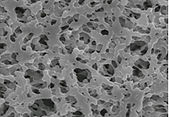




Types of Filtration
There are 3 main filtration stages in any beverage production. A fourth sterile has been added for explanation:
-
Primary / Pre-filtration (bulk filtration)
-
Polishing / Fine filtration (clarification)
-
Final Filtration (bottling)
-
Sterile filtration (bacteria removal)
Primary / Pre-Filtration
Used to removes all unwanted large particles (coarse filtration) to make the beverage visually clear. For example, filtering the juice just before fermentation most of the large particulates are filtered out only leaving a few for the yeast. After fermentation the yeast and all other large particulates are filtered out. At this stage you can use filters aids such as cellulose fibers and perlite to filter large volume. Bag filters, stacked lenticular filters and depth cartridges are commonly used for smaller volume at this step.
Polishing / Fine Filtration
Depending on the wine composition (solid content, turbidity, micro-organisms), a pleated cartridge will be used, with a pore size rating of 1 to 3 micron. The polypropylene and glass fiber pleated cartridges have a low pressure drop, high load capacity and efficiency. For large volume a tighter grade of cellulose fibers and perlite can be used. Smaller volume of wine would use glass fiber pleated cartridges to assist in haze removal due to the media’s inherent positive charge. This fine filtration step protects the membrane filter from being overloaded with particles and prematurely clogging. The pre-filter before a final filter is used before bottling as insurance for many wineries.
Final Filtration
Final filtration is the last filtration used before bottling. This filter is an absolute 0.65 micron for reds and 0.45 micron for whites. The recommendation is a highly asymmetrical PES membrane. It has a higher flow rate and throughput due to the structure of its membrane structure. A prefilter is place in front of the final filter that does the work protecting the final filter. It is recommended that they be placed in series rather than parallel in case one fails. Bottling can continue without interruption.
Sterile Filtration
Sterile filtration is considered 0.2 microns or less. For the beverage industry this tight of filtration is not required for two reasons. First what you are consuming does not have to be sterile. Second in the case of wine filtering too tight may remove some of the complexity out of the wine. If required, Fiber X Pro has filter membranes and cartridges to fit your applications.
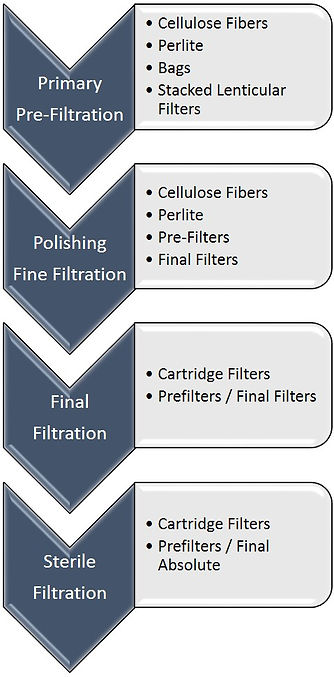
Cartridge Configuration
The filter cartridge consists of the membrane media, removal rating, end cap types, length, seal material and core. When combined the final result is your cartridge configuration.
Ordering Guide
Start by entering the desired filter membrane type. Select from each category and enter the number. For example, a PES 0.22-micron filter, 226 (SS insert)/spear fin end cap, 30 inch in length, silicone seal material and stainless steel insert core part number: PAA 0022 R 30 SS.

